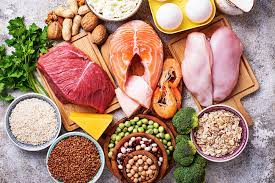Introduction
Protein metabolism denotes the various biochemical processes responsible for the synthesis of proteins and amino acids (anabolism), and the breakdown of proteins by catabolism. The steps of protein synthesis include transcription, translation, and post translational modifications.
VACABULARY: TO DENOTE, ANABOLISM, BREAKDOWN, CATABOLISM, SYNTHESIS, TRANSCRIPTION
Proteins serve a range of physiological functions in health and in disease. Their overall structure is determined predominantly by the sequence of amino acids when they are synthesized, which in turn is a derivative of the sequence of nucleotides in the corresponding segment of DNA. There is a constant turnover of body protein, the rate of which exceeds dietary protein intake and therefore suggests a degree of recycling. 
VOCABULARY: OVERALL, PREDOMINANTLY, SEQUENCE, DERIVATIVE, SEGMENT, TURNOVER, EXCEEDS, THEREFORE
Some amino acids that enter the body protein pool can be synthesized (‘non-essential’ amino acids) while others can only be obtained through dietary means (‘essential’ amino acids). During critical illness and significant trauma there appears to be dysregulation such that synthesis of some non-essential amino acids is limited, while there is an increase in amino acid oxidation. Modification of dietary intake to address the potential imbalance in illness is probably insufficient in isolation to prevent muscle wasting.
VOCABULARY: PROTEIN POOLTRAUMA, DYSREGULATION, INTAKE, IMBALANCE, INSUFFICIENT, WASTING, NON-ESSENCIAL, OBTAINED
Proteins serve a wide variety of functions. They are made by the sequential incorporation of amino acids in an order that is determined by genes and which in turn determine the final structure and thus the function of the protein. Proteins are constantly being synthesized and broken down at rates which exceed the amount of protein consumed in the diet and the equivalent amount of nitrogen that is excreted as urea in the urine. Some amino acids can be synthesized in the body (non-essential amino acids) but others (essential amino acids) must be supplied from dietary proteins in amounts that match the amounts that are oxidized.
VOCABULARY: TO SERVE, SEQUENCIAL, INCORPORATION, THUS, EXCRETED, UREA, URINE, MATCH
Hence the criterion of adequacy of a diet with respect to protein is its ability to maintain nitrogen balance in an adult and its ability to support normal growth in a child. During some critical illnesses there appears to be a constraint on the rate at which some non-essential amino acids can be synthesized, so that clinical benefits have been seen from supplementing the diet with these ‘conditionally-essential’ amino acids. Moreover, following surgery or during severe illness there is an increase in amino acid oxidation that can lead to muscle wasting. It is important to minimize the loss of lean tissue, but it may not be possible to prevent it completely by dietary means.
VOCABULARY: HENCE, CRITERION, ADAQUACY, ABILITY, GROWTH, CONDITIONALLY, MOREOVER, SEVERE, LEAD TO, MUSCLE WASTING, LEAN TISSUE
QUESTIONS:
Answer each question with a minumum of 50 words per answer.
- What are you main sources of protein?
- How many grams or calories of protein do you consume per day?
- What is the best source of protein, plant or animal?
- How do vegans maintain their protein intake?

